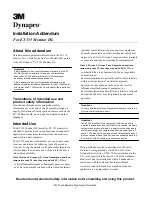
Form V372, Rev. 12
- 15 -
12/18, ECN4334
ix. The release of surfactants as intermediates during the degradation process. When
surfactants are digested anaerobically, they generate more gas.
x. Inadequate mixing, start-up conditions, shock/inconsistent loading rates. Again, any
time digestion and generation of the gases of decomposition are not spread out
evenly over time, the risk of foaming and RVE events is higher.
c. What are the causes of foaming that are within our control?
i. We can reduce mixing so that the digestion rate slows, generating less gas, thus
producing less foam while still maintaining mixing.
ii. The best method of reducing mixing in a digester is with Variable Frequency Drive
(VFD); 75% of full speed is the recommended lower limit, as we have discussed
earlier.
iii. Intermittent mixing is not the best method for reducing foaming and RVE problems
because it leaves pockets of undigested feed sludge in the digester, which then can
rapidly turn to gas on resumption of mixing.
d. To suppress foaming, we recommend
Vaughan’s Foambuster. Pumping digester sludge
through a nozzle and over a splashplate by use of the Foambuster generates thousands
of droplets, which are spread over the digester surface to break foam bubbles and
reduce foam levels. The Foambuster can be fed sludge by the main mixing pump or by a
separate pump to provide independent foam suppression control. The best approach is
to install the Foambuster with the Rotamix system so that there is a way to control
foaming right from the start. If foaming occurs after startup of the mixing system and a
Foambuster has not been installed with the system, the recovery costs for installing a
Foambuster are much higher.
D. Poor mixing can result if the viscosity of the mixed sludge is too high. This situation can occur
when mixing very thick TWAS (thickened waste activated sludge). Once TWAS gets up to the
range of 6-7% solids, mixing may be difficult to achieve. When TWAS concentrations are
higher than 6-7% solids, it is generally not possible to effectively mix this fluid.
a. The use of CFD (Computational Fluid Dynamics) in evaluating mixing systems in ultra-
viscous sludges has been extremely helpful. Vaughan Co. has significant CFD
capabilities and a great deal of experience with this method of analysis.
E. When mixing straw, grass and other materials that float, the mixing system often needs a
combination of Rotamix and propeller mixers to drive the floating material down into the slurry
to be hydrolyzed. Hydrolysis is the chemical breakdown of a compound due to reaction with
water.
F. Some Rotamix systems depend on two pumps pumping at the same time to send enough flow
through the nozzles to mix a very large volume
tank. On systems like this it’s not uncommon
for the plant operator to misunderstand that operation of only one pump is not effective and
may be operating the single pump in high flow cavitation. Cavitation can shorten pump life and
the life of the mechanical seal, in particular. The use of a VFD controller on each pump motor
as both pumps are operated is the correct way to reduce overall system flow, when required.
Alternatively, consider piping the system such that each pump independently feeds half the
mixing nozzles.


































